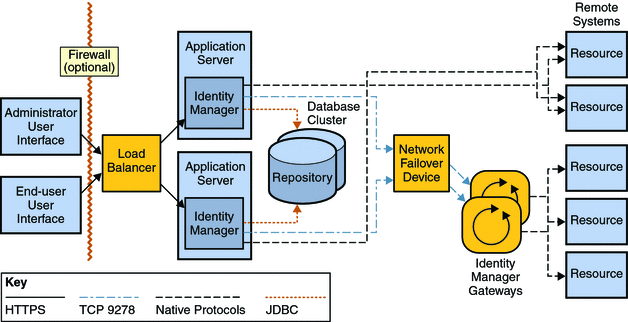Understanding the Recommended HA Architecture
The following diagram shows the Identity Manager architecture Sun recommends if there is no existing web application infrastructure.
Figure 3–2 Identity Manager High-Availability Architecture

In an actual deployment, existing redundant application server infrastructure should be utilized to the extent possible. The value of this architecture is that it only uses load balancers for achieving redundancy at the application server. Load balancers with session affinity detect failed application server instances and failover to active instances. Load balancers are also used to provide horizontal scaling in the web environment by spreading the user requests across a cluster of servers.
Though this is a straightforward architecture, the uptime characteristics are comparable to more complex deployments. Because of its simplicity, there are fewer pieces of software to maintain and monitor or fewer pieces that could fail. Because human error is the number one cause of downtime, a relatively simple solution may achieve better uptime characteristics than something more complex. There are no universal right answers. The point is to understand all of the causes of downtime and choose the architecture that will result in the best availability for the investment.
Note –
It would be impossible to describe all of the different HA architectures that are possible with a web application like Identity Manager.
Because Identity Manager can be deployed in a variety of possible combinations, it may be most economical to identify existing infrastructure and utilize as much of it as possible when deploying Identity Manager.
- © 2010, Oracle Corporation and/or its affiliates
